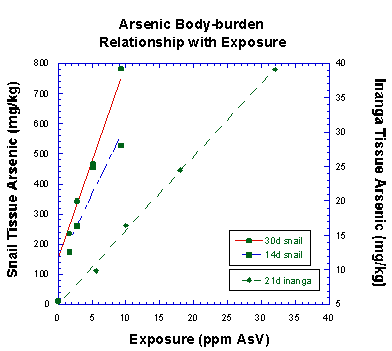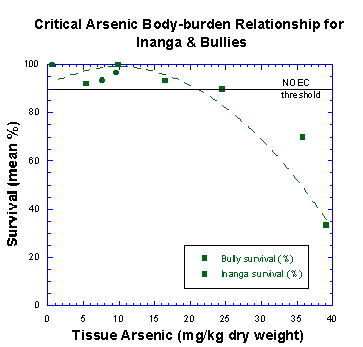Bioaccumulation and Chronic Toxicity (Critical Body
Concentrations) of Metals in Potamopyrgus antipodarum: An
Ecological Risk Assessment Tool
Christopher W. Hickey and Michael L. Martin
Organisms in the natural receiving environment are subjected to
widely time-varying exposures to contaminants as a result of continuous
and intermittent discharges. For contaminated land sites this
variability may be particularly large in relation to rainfall events,
groundwater level and soil moisture saturation. Measurements of total
metal concentrations in the receiving water are difficult and do not
provide estimates of toxicological effects because toxicity is a
function of exposure concentration, metal speciation and
bioavailability. Much of the metals discharged during rainfall events
will be particle associated and of low bioavailability.
Biological effects are usually a function of bioaccumulation. Thus,
whole body concentration should provide a better predictor of effects
than concentrations in sediment or water. Bioaccumulation-toxicity
response relationships for metals (As & Cu) have been determined for
three native species: the hydrobiid snail (Potamopyrgus antipodarum);
the common bully (Gobiomorphus cotidianus), and the inanga (Galaxias
maculatus). Critical body burdens were determined in chronic (20-30 day)
toxicity tests in the laboratory.
The results show marked differences in the concentration-response
relationships for the invertebrate and fish species. The snail
accumulated markedly arsenic higher body-burdens than the inanga for
comparable water concentrations (Figure 1).
Strong linear regressions indicated predictable species-specific
relationships between tissue accumulation and water column exposure.
Critical body-burden relationships were calculated for snails (Figure
2) and fish species (Figure 3) based on
measured snail morbidity (inability to overturn) and fish survival. The
indicative no observed effect concentrations (NOEC) were based on a 10%
effect threshold. The NOEC differed markedly between snails, at about
300 mg/kg, and the fish species, at about 22 mg/kg. Survival declines
rapidly above these critical body-burden thresholds for both snails and
fish species.

Figure 1. Summary plot
relating snail and bully exposure, accumulation and effects. Linear
regression lines through snail and fish (inanga) datasets.

Figure 2. Tissue
body-burden/ survival response relationship for arsenic exposure to snails
(line is second order polynomial through 14d data). Indicative no observed
effect concentration (NOEC) threshold is 300 mg/kgDW As.

Figure 3. Tissue
body-burden/ survival response relationship for arsenic exposure to
bullies and inanga (line is second order polynomial through all data).
Indicative no observed effect concentration (NOEC) threshold is 22 mg/kgDW
As.
Copper exposure body-burden relationships were only derived for inanga.
Tissue concentrations showed an increasing non-linear response with water
exposure (Figure 3). The critical body-burden response relationship
indicated a relatively wide tolerance range for copper with a critical
body-burden value of about 15 mg/kg Cu. Above this value inanga survival
markedly declines.
These bioaccumulation-toxicity relationships can be used to predict
chronic toxicity based on total body concentration for biomonitoring using
indigenous field populations and for metal accumulated in short-term in
situ transplanted organisms. The biomonitoring suitability is greater for
snails for a number of reasons, including: (i) their lower natural
mobility; (ii) suitability for long-term housing in simple cage systems;
and (iii) ability to assess both sediment and water column associated
contaminant bioavailability. Comparison of metal bioaccumulation with
critical body burden concentrations can help to identify cause-effect
relationships and related exposure conditions with adverse effect
thresholds for individual species. Thus metal bioaccumulation can provide
valuable quantitative tools for use in risk or environmental impact
assessment if critical body burdens have previously been determined.
|
![]()


